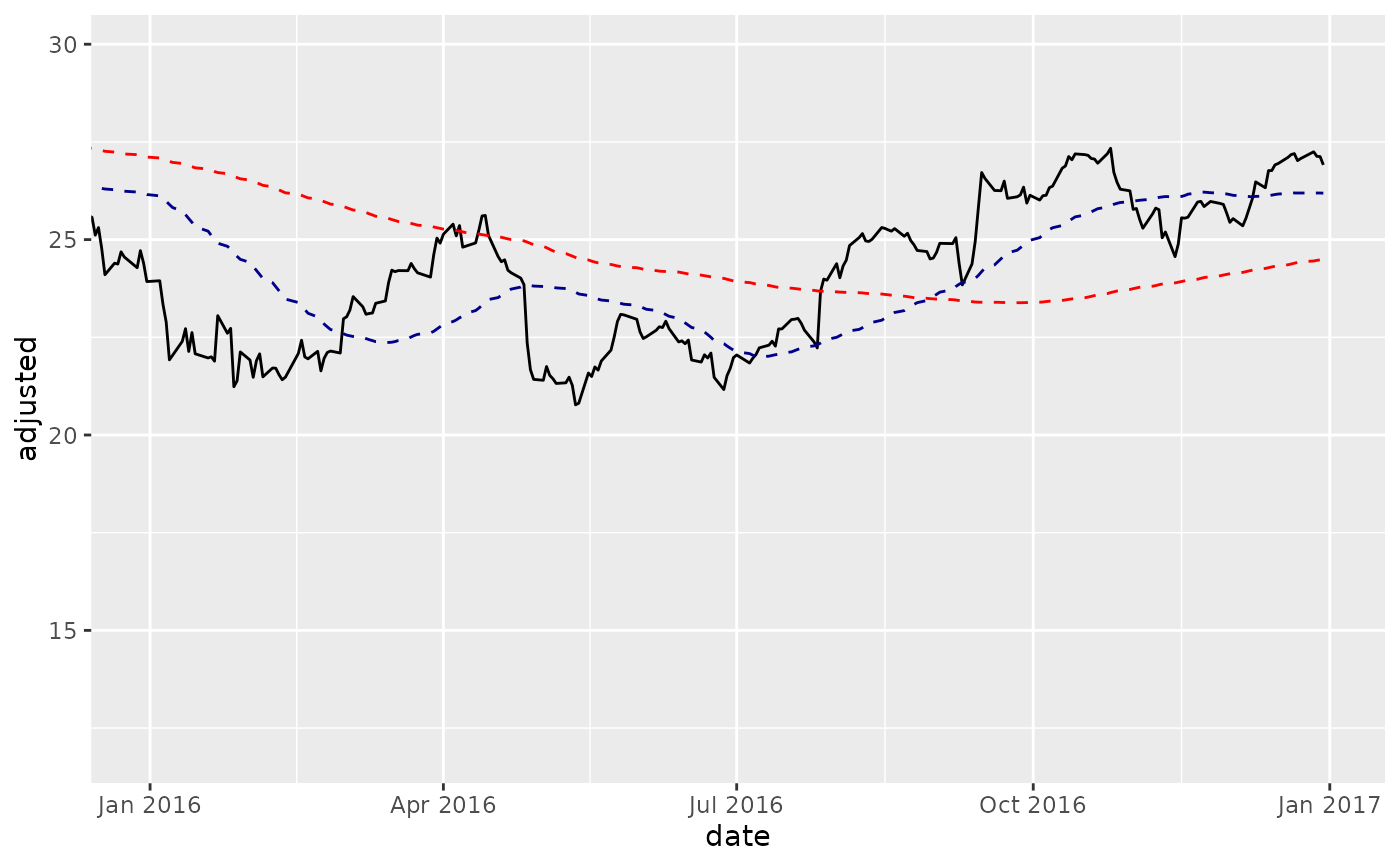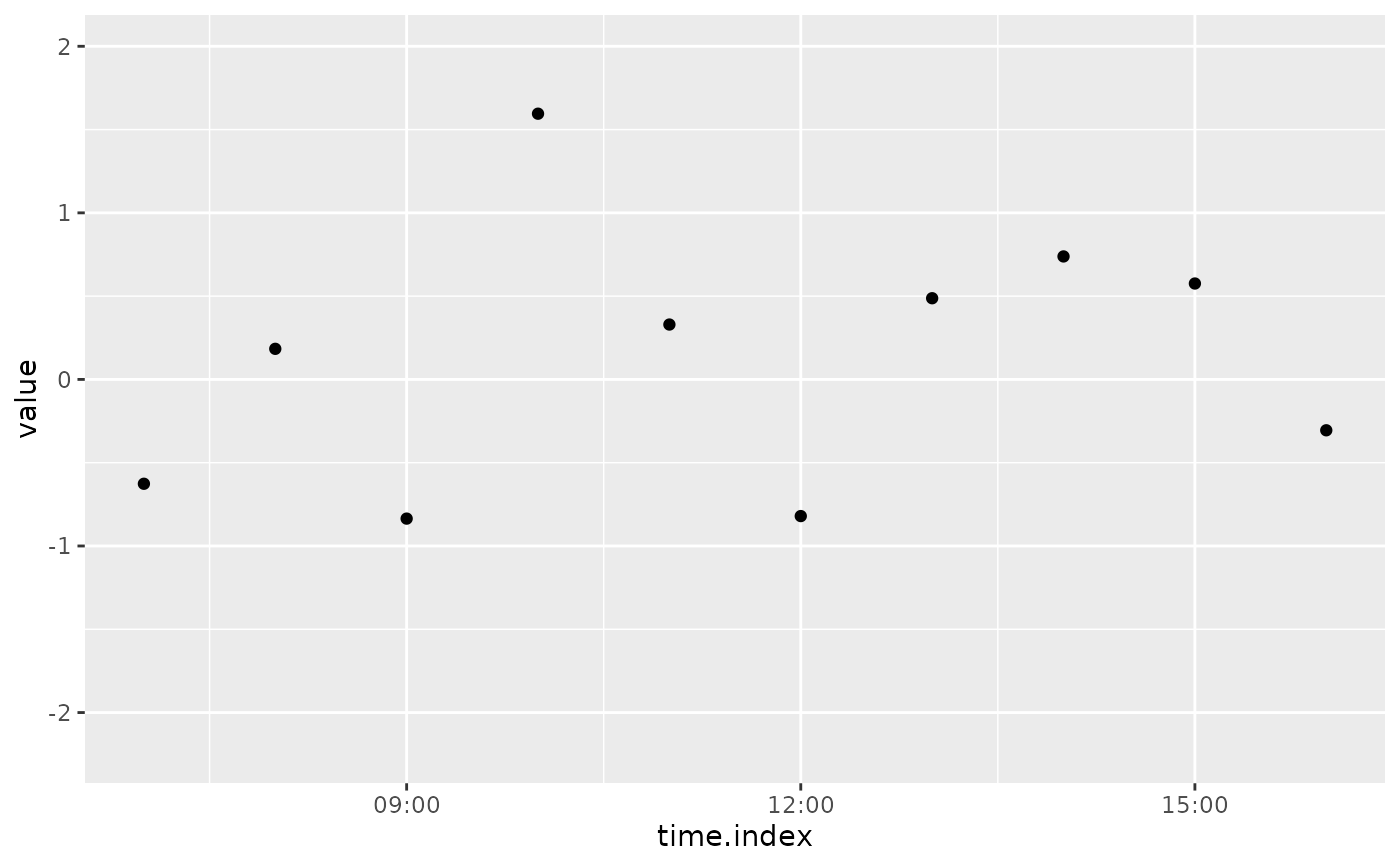
Zoom in on plot regions using date ranges or date-time ranges
Source:R/ggplot-coord_date.R
coord_x_date.RdZoom in on plot regions using date ranges or date-time ranges
Usage
coord_x_date(xlim = NULL, ylim = NULL, expand = TRUE)
coord_x_datetime(xlim = NULL, ylim = NULL, expand = TRUE)Arguments
- xlim
Limits for the x axis, entered as character dates in "YYYY-MM-DD" format for date or "YYYY-MM-DD HH:MM:SS" for date-time.
- ylim
Limits for the y axis, entered as values
- expand
If
TRUE, the default, adds a small expansion factor to the limits to ensure that data and axes don't overlap. IfFALSE, limits are taken exactly from the data orxlim/ylim.
Details
The coord_ functions prevent loss of data during zooming, which is
necessary when zooming in on plots that calculate stats using data
outside of the zoom range (e.g. when plotting moving averages
with geom_ma()). Setting limits using scale_x_date
changes the underlying data which causes moving averages to fail.
coord_x_date is a wrapper for coord_cartesian
that enables quickly zooming in on plot regions using a date range.
coord_x_datetime is a wrapper for coord_cartesian
that enables quickly zooming in on plot regions using a date-time range.
Examples
# Load libraries
library(dplyr)
#>
#> ######################### Warning from 'xts' package ##########################
#> # #
#> # The dplyr lag() function breaks how base R's lag() function is supposed to #
#> # work, which breaks lag(my_xts). Calls to lag(my_xts) that you type or #
#> # source() into this session won't work correctly. #
#> # #
#> # Use stats::lag() to make sure you're not using dplyr::lag(), or you can add #
#> # conflictRules('dplyr', exclude = 'lag') to your .Rprofile to stop #
#> # dplyr from breaking base R's lag() function. #
#> # #
#> # Code in packages is not affected. It's protected by R's namespace mechanism #
#> # Set `options(xts.warn_dplyr_breaks_lag = FALSE)` to suppress this warning. #
#> # #
#> ###############################################################################
#>
#> Attaching package: ‘dplyr’
#> The following objects are masked from ‘package:xts’:
#>
#> first, last
#> The following objects are masked from ‘package:stats’:
#>
#> filter, lag
#> The following objects are masked from ‘package:base’:
#>
#> intersect, setdiff, setequal, union
library(ggplot2)
# coord_x_date
AAPL <- tq_get("AAPL", from = "2013-01-01", to = "2016-12-31")
AAPL %>%
ggplot(aes(x = date, y = adjusted)) +
geom_line() + # Plot stock price
geom_ma(n = 50) + # Plot 50-day Moving Average
geom_ma(n = 200, color = "red") + # Plot 200-day Moving Average
# Zoom in
coord_x_date(xlim = c("2016-01-01", "2016-12-31"))
 # coord_x_datetime
time_index <- seq(from = as.POSIXct("2012-05-15 07:00"),
to = as.POSIXct("2012-05-17 18:00"),
by = "hour")
set.seed(1)
value <- rnorm(n = length(time_index))
hourly_data <- tibble(time.index = time_index,
value = value)
hourly_data %>%
ggplot(aes(x = time.index, y = value)) +
geom_point() +
coord_x_datetime(xlim = c("2012-05-15 07:00:00", "2012-05-15 16:00:00"))
# coord_x_datetime
time_index <- seq(from = as.POSIXct("2012-05-15 07:00"),
to = as.POSIXct("2012-05-17 18:00"),
by = "hour")
set.seed(1)
value <- rnorm(n = length(time_index))
hourly_data <- tibble(time.index = time_index,
value = value)
hourly_data %>%
ggplot(aes(x = time.index, y = value)) +
geom_point() +
coord_x_datetime(xlim = c("2012-05-15 07:00:00", "2012-05-15 16:00:00"))
